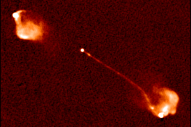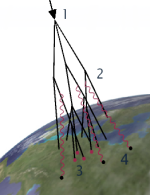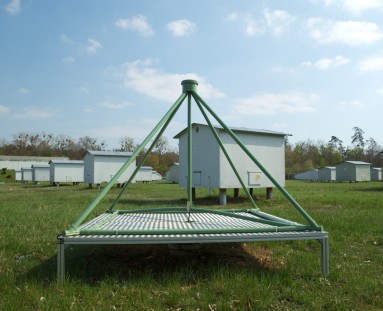Cosmic bullets
 Something in space is hurling around particles with incredible force. Even the tiniest of these particles, so small that they are invisible to the human eye, can have the impact of a speeding bullet. Do they come from cosmic explosions? From black holes spitting out the remains of objects they sucked in? Are galactic collisions responsible? Answering these questions will improve our understanding of the universe. For now, however, the sources of these energetic particles, which we call cosmic rays, remain a mystery.
Something in space is hurling around particles with incredible force. Even the tiniest of these particles, so small that they are invisible to the human eye, can have the impact of a speeding bullet. Do they come from cosmic explosions? From black holes spitting out the remains of objects they sucked in? Are galactic collisions responsible? Answering these questions will improve our understanding of the universe. For now, however, the sources of these energetic particles, which we call cosmic rays, remain a mystery.
 If we don't know what these sources are, then how do we know they exist? This is simply because some of the particles, which are flying off in all directions, find the Earth on their way. What happens next is not unlike cueing off in a game of snooker: the incoming particle smashes into our atmosphere (1), where its energy is distributed over many other particles, which, in their turn, bump into other particles… This chain reaction results in a shower of billions of particles rushing down through the atmosphere (2). This shower dies out slowly, but a small fraction of the affected particles eventually reach the ground (3). All this firework is over in an instant: from the first collision to the moment the last particle has reached the ground, less than a millisecond will have passed.
If we don't know what these sources are, then how do we know they exist? This is simply because some of the particles, which are flying off in all directions, find the Earth on their way. What happens next is not unlike cueing off in a game of snooker: the incoming particle smashes into our atmosphere (1), where its energy is distributed over many other particles, which, in their turn, bump into other particles… This chain reaction results in a shower of billions of particles rushing down through the atmosphere (2). This shower dies out slowly, but a small fraction of the affected particles eventually reach the ground (3). All this firework is over in an instant: from the first collision to the moment the last particle has reached the ground, less than a millisecond will have passed.
The few particles that make it all the way to the ground, can be detected. This principle has been the cornerstone of cosmic ray research for decades. The more particles we can detect, the closer this would bring us to our goal of finding the origins of the incredible energies of cosmic rays. But there's a snag: only the particles that actually make it to the ground are accounted for. So how can we know down here what happens up there, way up in the atmosphere?
Many efforts have been made to deal with this problem. Detector arrays were put at high altitudes or on hot air balloons. These solutions are not very flexible or practical, as you might imagine. So we had to circumvent the particle problem and try something else. Now, we know that different kinds of particles are participating in the particle shower, among which are particles which have an electrical charge. We also know that the Earth is surrounded by a magnetic field. And it has been known for a long time that charged particles in a magnetic field produce radiation (4). Radiation is not absorbed in the atmosphere, like the particles, and is easy to detect. What if were to try and measure this radiation?
A setup to test this theory can be of very simple design. We got ten antennas, like the one on your fm radio, and placed them near a particle detector array. Whenever this array was hit by a shower of particles, we looked at the signal we received in our antennas. Not only did we measure a flash of radiation, as we expected, we could also pinpoint the origin of this flash to the exact same direction as the particle shower. We rejected the other explanation of the phenomenon, that it was the sparks of a welder producing the radiation, at half past one at night, several kilometers up in the air.
In short, this is a promising new way of detecting cosmic rays. We managed to do it with only ten simple antennas. Now we propose to use a new radio antenna network to search for cosmic rays, which consists of ten thousand antennas. Will we solve the mystery of the origin of cosmic rays? At least it will bring us closer to a solution…
